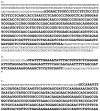Four independent mutations in the feline fibroblast growth factor 5 gene determine the long-haired phenotype in domestic cats
- PMID: 17767004
- PMCID: PMC3756544
- DOI: 10.1093/jhered/esm072
Four independent mutations in the feline fibroblast growth factor 5 gene determine the long-haired phenotype in domestic cats
Abstract
To determine the genetic regulation of "hair length" in the domestic cat, a whole-genome scan was performed in a multigenerational pedigree in which the "long-haired" phenotype was segregating. The 2 markers that demonstrated the greatest linkage to the long-haired trait (log of the odds > or = 6) flanked an estimated 10-Mb region on cat chromosome B1 containing the Fibroblast Growth Factor 5 (FGF5) gene, a candidate gene implicated in regulating hair follicle growth cycle in other species. Sequence analyses of FGF5 in 26 cat breeds and 2 pedigrees of nonbreed cats revealed 4 separate mutations predicted to disrupt the biological activity of the FGF5 protein. Pedigree analyses demonstrated that different combinations of paired mutant FGF5 alleles segregated with the long-haired phenotype in an autosomal recessive manner. Association analyses of more than 380 genotyped breed and nonbreed cats were consistent with mutations in the FGF5 gene causing the long-haired phenotype in an autosomal recessive manner. In combination, these genomic approaches demonstrated that FGF5 is the major genetic determinant of hair length in the domestic cat.
Figures





References
-
- Boutin-Ganache I, Raposo M, Raymond M, Deschepper CF. M13-tailed primers improve the readability and usability of microsatellite analyses performed with two different allele-sizing methods. Biotechniques. 2001;31:24–26. 28. - PubMed
-
- Brownstein MJ, Carpten JD, Smith JR. Modulation of non-templated nucleotide addition by Taq DNA polymerase: primer modifications that facilitate genotyping. Biotechniques. 1996;20:1004–1006. 1008–1010. - PubMed
-
- Burns M, Fraser MN. Genetics of the dog: the basis of successful breeding. Edinburgh, Scotland: Oliver and Boyd; 1963.
-
- Clements DA, Wang J-K, Dionne CA, Goldfarb M. Activation of fibroblast growth factor (FGF) receptors by recombinant human FGF5. Oncogene. 1993;8:1311–1316. - PubMed
-
- Dickie MN. New mutations. I. Angora. Mouse News Lett. 1963;29:39.
Publication types
MeSH terms
Substances
Grants and funding
LinkOut - more resources
Full Text Sources
Other Literature Sources
Miscellaneous

